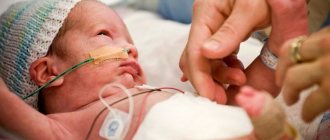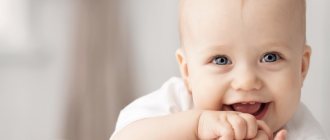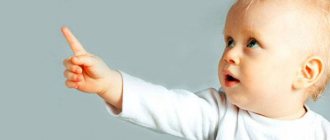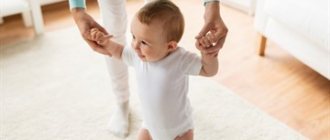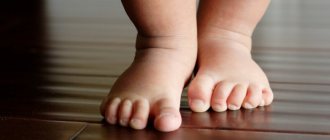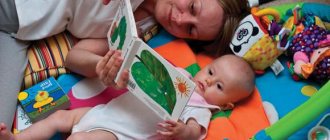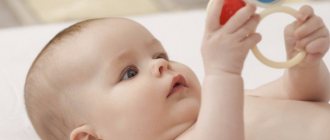At this age, children, as a rule, already have the basic abilities that are so necessary for further knowledge of the world around them. For this reason, in order to promptly detect a delay in the development of their baby, it is extremely important for parents to know what a child should be able to do at the age of 1, what skills he should have by this time. Find out more about this period of baby growing up.
Height and weight of a 1 year old child, data from domestic pediatricians
| 1 year | Bottom line | Upper limit |
| Boys' weight, kg | 8,9 | 11,6 |
| Girls' weight, kg | 8,5 | 10,8 |
| Boys' height, cm | 72,3 | 79,7 |
| Girls' height, cm | 71,4 | 78,0 |
| Boys' head circumference, cm | 45,3 | 48,6 |
| Head circumference of girls, cm | 44,2 | 47,3 |
| Boys chest circumference, cm | 46,1 | 52,5 |
| Girls chest circumference, cm | 46,3 | 51,4 |
One-year-old baby routine
Parents of many children who have reached the 1 year mark often face the problem of changing their routine. At this age, the child has difficulty falling asleep during the day at the same time, so daytime rest is pushed back to a later time. As a rule, “night owls” behave this way, waking up at 9–10 o’clock in the afternoon, and then resting at 14–15 o’clock. That is, the child sleeps once a day for 2 - 3 hours, from about 15 to 18 hours, and at night he goes to bed at 22 - 23 hours.
After such changes, it is necessary to reconsider the baby’s diet. If the baby has switched to a single long nap during the day, then feeding him 5–6 times will not work. Then the baby eats 4 times, for example, at 9.00 he has breakfast, at 13.00 - lunch, at 17.00 - afternoon snack and 21.00 - dinner.
If the newborn’s routine has not changed, then nothing needs to be changed.
Height and weight of children aged 1 year WHO data
| 1 year | Bottom line | Upper limit |
| Boys' weight, kg | 7,7 | 12,0 |
| Girls' weight, kg | 7,0 | 11,5 |
| Boys' height, cm | 71,0 | 80,5 |
| Girls' height, cm | 68,9 | 79,2 |
| Boys' head circumference, cm | 43,5 | 48,6 |
| Head circumference of girls, cm | 42,2 | 47,6 |
Differences in the development of boys and girls at 1 year
Boys and girls at 1 year of age do not differ much in development. Almost every one-year-old child can walk independently or holding onto a support, but mostly crawls on all fours. A one-year-old baby can sit, squat and stand up without difficulty. By 12 months, the child’s activity and curiosity are gaining momentum.
The baby begins to independently climb on and off a small hill, such as a sofa, and likes to open doors on furniture sets and examine the contents. A period of active imitation of parents with gestures begins, and every day the child becomes more and more independent.
Motor skills allow him to lift and throw objects, which is what happens actively; he can pick up 2 toys with one hand, and several with two handles at once. The child reacts and fulfills the simplest requests, for example, “bring the ball”, “take the bottle”, and consciously understands when parents explain what is possible and what is not.
The baby's development allows him to stack several cubes in the form of a tower, play with a pyramid, open various boxes and hide something there. The perception of sounds occurs, the child, knocking with some object, makes a sound and actively listens to the sound. Often children begin to experiment with their own voice, making different sounds.
Children have approximately 8 teeth per year, but this figure is individual. Against the background of all childhood events, impressions and a leap in development, the first crisis of one year occurs. This crisis may change behavior for the worse. The child may demand more independence and react to the actions of the parents with hysterics. In such situations, parents should be patient and distract him as much as possible with a book or other toy.
At about 1 year old, you can start putting your child on the potty. It is advisable to carry out these activities after feeding and sleep, every hour and a half. Over time, a habit will develop, and the child will independently begin to communicate that he wants to go to the toilet.
Cognitive development of a 1 year old child
Removes and strings 3-4 rings with a wide hole onto the pyramid rod:
- imitating the actions of an adult,
- on one's own.
Opens and closes lids:
- by imitation,
- in an independent game.
Places one cube on top of another (by imitation).
Performs different actions with one familiar figurative toy: feeds, wipes, combs. Performs two or three actions separately:
- by imitation,
- in independent games (if the game situation is created),
- at the request of an adult.
Imitates the play actions of a peer: pats, pours, breaks, pulls. Rolls a ball (ball), pushes a toy on wheels forward. Independently closes and opens doors, turns on the radio, TV, pulls out drawers, etc.
The second year of your amazing life has begun.
In the first half of the second year of life, mainly the improvement and consolidation of those skills that arose at the end of the first year of life occurs. First of all, walking improves.
By the age of one and a half years, the baby can step over obstacles with an extended step and begins to run. At this age, the child is very active - he runs several kilometers a day. And at the same time he doesn’t get tired! The baby develops ideas about the distance and location of objects in space. And increased physical activity increases interest in everything that surrounds him. The young researcher wants to touch everything, taste it by heart.
Your baby still largely depends on adults, especially on his mother. But he strives for independence, expresses his displeasure by crying, is stubborn if he is not understood, loves to communicate with adults, knows how to be cunning, be surprised by new things and rejoice from the heart. He is full of energy and ready to share it with you.
Each child develops at his own individual pace. Different children develop their own capabilities at different times.
However, there are age standards: how and when a child should start walking, running, drawing, talking, reading, writing...
All these frameworks show parents no later than what period a particular function should develop. If it is not formed by the required age, it is customary to speak of developmental delay. This usually happens if the baby is seriously ill or when no one cares for him.
Get to know the skills your child should acquire by a certain age. Don't be upset if your baby can't cope with some things yet. This is a hint for you - what he needs to practice.
After all, it’s worth paying at least a little attention to the child, teaching him through play, telling him something, showing him pictures, reading books, and he begins to get wiser and grow up by leaps and bounds. But if your anxiety does not go away, the baby does not know much of what he is supposed to do at his age, be sure to consult a pediatrician and psychologist.
Emotional and social development of a child at the age of 1 year
Smiles, rejoices, acting with a toy, especially with a favorite one. Enjoys wind-up toys and fun games with adults.
Dissatisfied:
- with the word “impossible”,
- in the harsh tone of an adult's voice,
- inability to perform the desired action.
Rejoices at the arrival of a loved one. Imitates the facial expressions of an adult. Imitates facial expressions, playful movements, and gestures of a peer. Looks questioningly at an adult when there are difficulties or in unfamiliar situations. Cries, becomes wary when a stranger appears. Smiles, recognizing a photograph of a loved one. Shows interest in pictures in books. Smiles, jumps up, “sings along” or calmly listens to the sounds of music, to a song.
Communication skills of a one-year-old child
It is believed that by the first birthday a baby should be able to speak at least a couple of simple words. Most children confirm this theory, but if a child is silent at one year old, this does not mean that he is behind in development. You need to watch him, make sure that the baby hears the speech of the people around him, reacts to it, for example, holds out a toy when asked: “Give me.” In this case, there is no need to worry, even if the baby does not say a word in response.
There are children in a hurry who at this age pronounce up to 10 meaningful words: ma-ma, pa-pa, aw, am, na, give and others. Basically, early speech development is typical for girls; boys remain silent longer.
Basically, by the age of one year, a child can:
- hear and understand speech addressed to him, fulfill simple requests;
- knows his name, reacts when someone says it;
- seeing himself in the mirror or in a photo, he understands that it is him, and when asked “who is this?” - can point to himself with a pen;
- understands the words “can” and “can’t”, listens when adults tell him “no”.
At the age of one year, children love to play with adults, listening to their conversations, trying to understand the words spoken, and catching emotions and intonations of voice. In addition, when communicating with a baby, you can notice how he tries to imitate adults, repeating their actions and behavior. According to the website TheRebenok.ru, the more time parents spend communicating and playing with their child, the more healthy and socially adapted he will grow up.
Speech development of a 1 year old child
Speech understanding:
Performs familiar actions with a toy (puts it in, opens it, carries it) at the request of an adult. Points to one of four familiar toys, to one of two pictures after the adult’s request: “Show me this and that.” Finds, distinguishing a cube from a brick (from a ball), at the request of an adult. Fulfills the request: “put it down”, “give it away”, “carry it”, “close it”, “open it”. Submits to the words “you can’t”, “you can”. Knows the names of close adults (looks towards the named person). Knows the names of his clothes and household items (shows).
Waves his hand when an adult says “goodbye”:
- when someone leaves
- when he leaves on his own.
He spreads his hands at the word “no.”
At the request of an adult:
- plays "okay"
- shows how something flies (waves his arms),
- shows what someone is doing (sitting, lying),
- hiding while playing peek-a-boo
- “wipes” his nose with a handkerchief,
- “wipes” his face by applying a towel.
Active speech (8-12 spoken words):
In simplified words he answers the adult’s question: “Who is this?” Light words are correlated with objects and actions (he names them himself). Easily imitates familiar sounds and movements (cries, laughs, coughs, sings, screams for animals). Imitating, he “talks” on the phone. Imitates the intonations of a song. Imitates the understandable words of other children. Easily imitates new words, repeating after an adult (intonation, rhythm).
Features of physical development of a one-year-old child
Around the time a child turns one year old, one of the main changes in his physical development occurs - he gets on his feet and takes his first steps. Some babies start walking before their first birthday, others a little later. But one way or another, the baby acquires the skill of independent movement and learns to use it at his own discretion.
Here is a list of the most significant changes in the physical development of a one-year-old child.
- He knows how to pick up not only large objects, but also small ones, grasping them with his fingers.
- Learns to climb onto a chair, sofa, armchair on his own and tries to get down to the floor.
- Holding onto a support, he can kick the ball, and while sitting, he can throw it with his hands.
- Able to build a tower from two or three cubes.
- Trying to leaf through the pages of a big book.
- He learns to hold a spoon in his hands, repeats after his mother when scooping up food, and holds a cup with his hands.
In addition, babies at this age confidently change positions from sitting to standing and vice versa. Some people still need support for this, and some “in a hurry” try to do it on their own.
It is important to support the baby and help him in his pursuit of further development, to let go of his hand more often, especially when he asks for it. Curiosity and inquisitiveness at this age are stronger than fear, so the child quickly masters the space around him.
Nutrition
As before, the baby gets five meals a day. His menu is quite varied, because he became acquainted with cereals, meat products, fish, bakery products, butter and vegetable oil, fruits and vegetables.
Children at 12 months eat almost the same as adults. Only the requirements for cooking remain special: preferably steamed or oven-cooked food, low-fat, avoid pickles and spicy foods.
Calm, just calm...
Psycho-emotional development
- The child expresses his feelings: hugs, kisses, even scolds like adults.
- He can dance and sing in his own language.
- Recognizes relatives from photographs and expresses joy when they come to visit.
- Shows mixed feelings towards strangers: from curiosity to suspicion.
- He knows his books, loves to look through them, show where the duck is drawn, where the chicken is, etc.
- Imitates adults when talking on the phone, copying tone of voice, facial expressions and gestures.
- Able to bite off and chew small pieces of solid food.
- He eats from a spoon and tries to spear food on a fork. Not everything is perfect yet, but the main essence of the process is captured.
- Drinks from a mug independently, supporting it with both hands. Some children still drink from a sippy cup or sippy cup.
- Participates in the dressing process by extending his arms into sleeves or inserting his feet into shoes. As before, many little ones don’t like to get dressed, but now they understand that once we get dressed, it means we’ll go for a walk, and for the sake of this we can endure it.
- The baby understands that it is much more comfortable in dry pants than in wet ones, so he loudly and clearly announces the “accident.” If they try to put the baby on the potty, he understands what they want from him.
The purpose of toys at one year of age is to develop imagination
